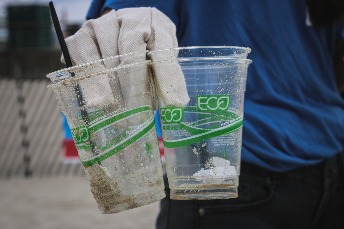The shiny world of greenwashing

Greenwashing, a term that makes the sustainable community shiver to the bone. If you haven’t heard of it yet, Mattanja will give us a short introduction to the shiny world of greenwashing and how to deal with it. And no, it doesn’t have anything to do with laundry!
Greenwashing is the strategy of making something appear sustainable when it is NOT. It’s that leaf-shaped plastic bottle with a green seemingly recycled sticker on it, as discussed in my last piece. It’s the big brand that puts on a green jacket for a change, to attract new customers. And for some reason, this strategy is legal. And for a less surprising reason, this strategy is working.
Sustainable journey
We live in a consumer-based society of always wanting more. This results in the dominating thought of always needing more. And ever since the climate protests gained ground in all of Europe, this need has been abused by the consumer industry. It decided to combine the sustainability trend with its desire to make even more money, and so the strategy of greenwashing gained ground.
More and more people take on the journey of living a more sustainable lifestyle. I specifically use the word journey because it’s not something that you can achieve overnight. On this journey, there are a lot of side roads and greenwashing is such a side road and - without you knowing it - it will take you straight back to where you started. So, how can you avoid that road?

How to spot greenwashing?
The first step is to be attentive when walking through a store. Question vague terms on products, like “eco-friendly”, “sustainable” and “made with love for the environment”. These are very unspecific terms that don’t tell you anything about the actual sustainability of the product. Second, look at the fine print on products meaning, the backside of a shampoo bottle or the label of a t-shirt. It’s likely that they will already tell you more about the sustainability of the product. Third, one of the most important questions you can ask yourself while searching for sustainability in a store is: is it too good to be true? For example, would that bamboo toothbrush of 1 euro really be sustainable or is it yet another marketing trick?
If you want to dig deeper into the world of greenwashing, you can try to find sustainability reports or independent investigations of certain stores. Those reports can give you more insight into the role that sustainability plays for the company.
You can do this!
These are just a few tips that can help you to move away from greenwashing, towards an actual sustainable lifestyle. Let this seemingly green image resonate through your mind the next time you’re strolling down the shopping street. Ask yourself: is it too good to be true? And then pick your path accordingly. Trust me, you can do it!
Hi! My name is Mattanja, I am a third year Dutch student of the Art History Ba. I try to live as much of a waste-free, sustainable lifestyle as possible and through my love of writing, I aim to share this lifestyle with others!

